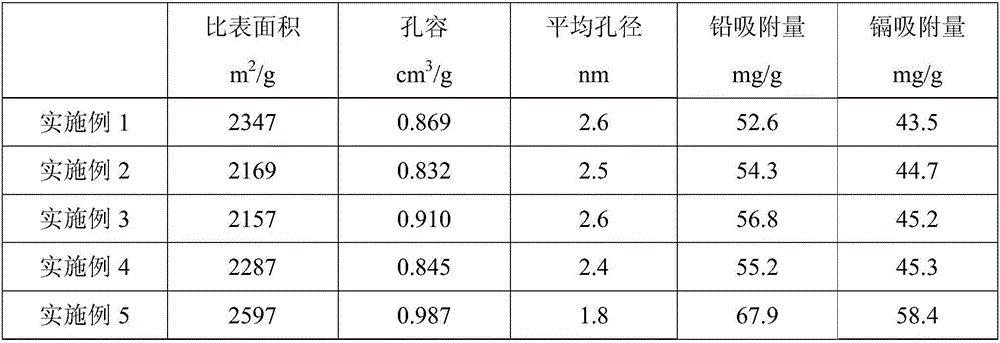Preparation method for reed-based active carbon
A technology of activated carbon and reed, applied in the field of preparation of reed-based activated carbon, can solve the problems of leaves and dry rice stalks falling into the water environment, affecting the cycle of pollutants in sewage, etc., and achieve a good adsorption effect.
- Summary
- Abstract
- Description
- Claims
- Application Information
AI Technical Summary
Problems solved by technology
Method used
Image
Examples
Embodiment 1
[0017] A preparation method for reed-based activated carbon, comprising the following steps:
[0018] Step 1, taking reeds, drying and crushing to obtain dry reed powder;
[0019] Step 2, in parts by weight, mix 10 parts of reed dry powder with 2 parts of acetic acid, 0.4 part of phosphoric acid, 0.05 part of sodium alginate, and 10 parts of water, soak at 30°C for 24 hours, and dry to obtain a modified dry powder;
[0020] Step 3, in parts by weight, mix 10 parts of modified dry powder with 0.5 part of sodium carbonate and 0.1 part of sodium lauryl sulfate, disperse, heat up to 100°C and keep it for 20 minutes to obtain a mixture;
[0021] Step 4, heating the obtained mixture to 700°C for 200 min in a nitrogen atmosphere, cooling, and grinding to obtain the obtained mixture.
[0022] Among them, the particle size of dry reed powder in step 1 is 10-20 mesh; the drying temperature in step 2 is 70°C; the dispersion condition in step 3 is 1000rpm, 15min, and the heating rate is ...
Embodiment 2
[0024] A preparation method for reed-based activated carbon, comprising the following steps:
[0025] Step 1, taking reeds, drying and crushing to obtain dry reed powder;
[0026] Step 2, in parts by weight, mix 10 parts of dry reed powder with 3 parts of acetic acid, 0.7 parts of phosphoric acid, 0.08 parts of sodium alginate, and 17 parts of water, soak at 35°C for 17 hours, and dry to obtain a modified dry powder;
[0027] Step 3, in parts by weight, mix 10 parts of modified dry powder with 0.7 part of sodium carbonate and 0.1 part of sodium lauryl sulfate, disperse, heat up to 110°C and keep it for 15 minutes to obtain a mixture;
[0028] Step 4: Heat the obtained mixture to 750°C for carbonization for 150 minutes in a nitrogen atmosphere, cool and grind to obtain the obtained mixture.
[0029] Among them, the particle size of dry reed powder in step 1 is 10-20 mesh; the drying temperature in step 2 is 80°C; the dispersion condition in step 3 is 1100rpm, 12min, and the he...
Embodiment 3
[0031] A preparation method for reed-based activated carbon, comprising the following steps:
[0032] Step 1, taking reeds, drying and crushing to obtain dry reed powder;
[0033] Step 2, in parts by weight, mix 10 parts of reed dry powder with 5 parts of acetic acid, 0.9 part of phosphoric acid, 0.08 part of sodium alginate, and 17 parts of water, soak at 30°C for 24 hours, and dry to obtain a modified dry powder;
[0034] Step 3, in parts by weight, mix 10 parts of modified dry powder with 0.9 part of sodium carbonate and 0.5 part of sodium lauryl sulfate, disperse, heat up to 100°C and keep it for 20 minutes to obtain a mixture;
[0035] Step 4, heating the obtained mixture to 700°C for 200 min in a nitrogen atmosphere, cooling, and grinding to obtain the obtained mixture.
[0036] Among them, the particle size of dry reed powder in step 1 is 10-20 mesh; the drying temperature in step 2 is 70°C; the dispersion condition in step 3 is 1000rpm, 15min, and the heating rate is ...
PUM
| Property | Measurement | Unit |
|---|---|---|
| particle size | aaaaa | aaaaa |
| specific surface area | aaaaa | aaaaa |
| pore size | aaaaa | aaaaa |
Abstract
Description
Claims
Application Information
 Login to View More
Login to View More - R&D
- Intellectual Property
- Life Sciences
- Materials
- Tech Scout
- Unparalleled Data Quality
- Higher Quality Content
- 60% Fewer Hallucinations
Browse by: Latest US Patents, China's latest patents, Technical Efficacy Thesaurus, Application Domain, Technology Topic, Popular Technical Reports.
© 2025 PatSnap. All rights reserved.Legal|Privacy policy|Modern Slavery Act Transparency Statement|Sitemap|About US| Contact US: help@patsnap.com

